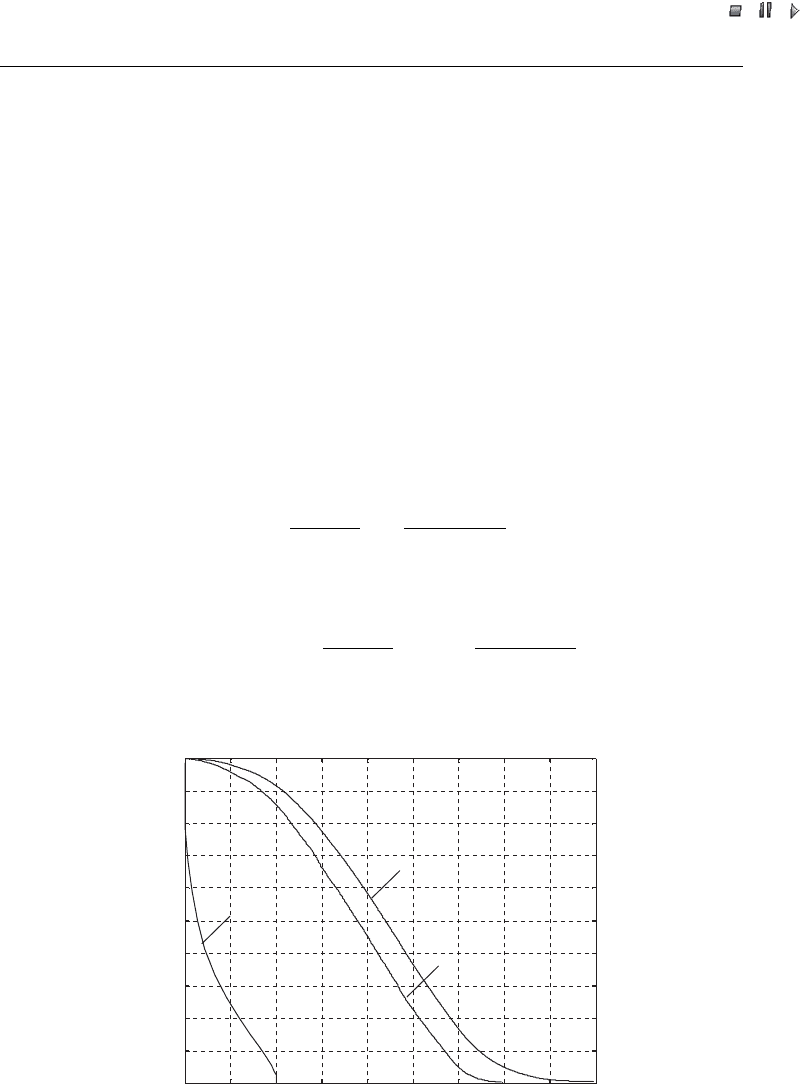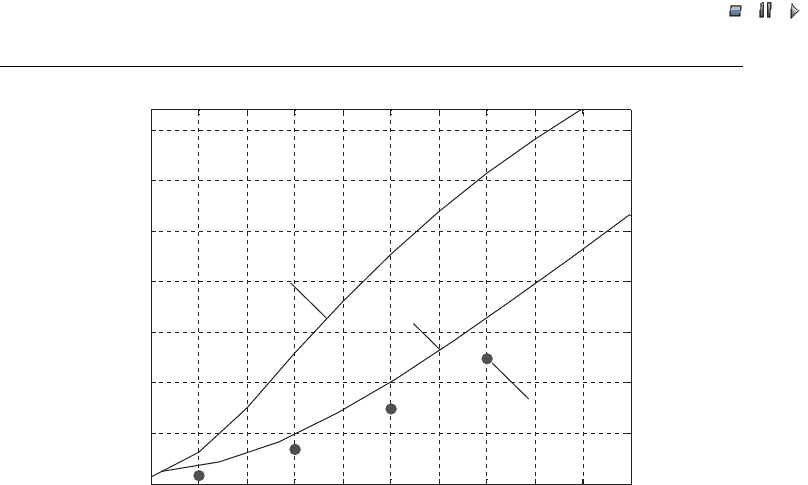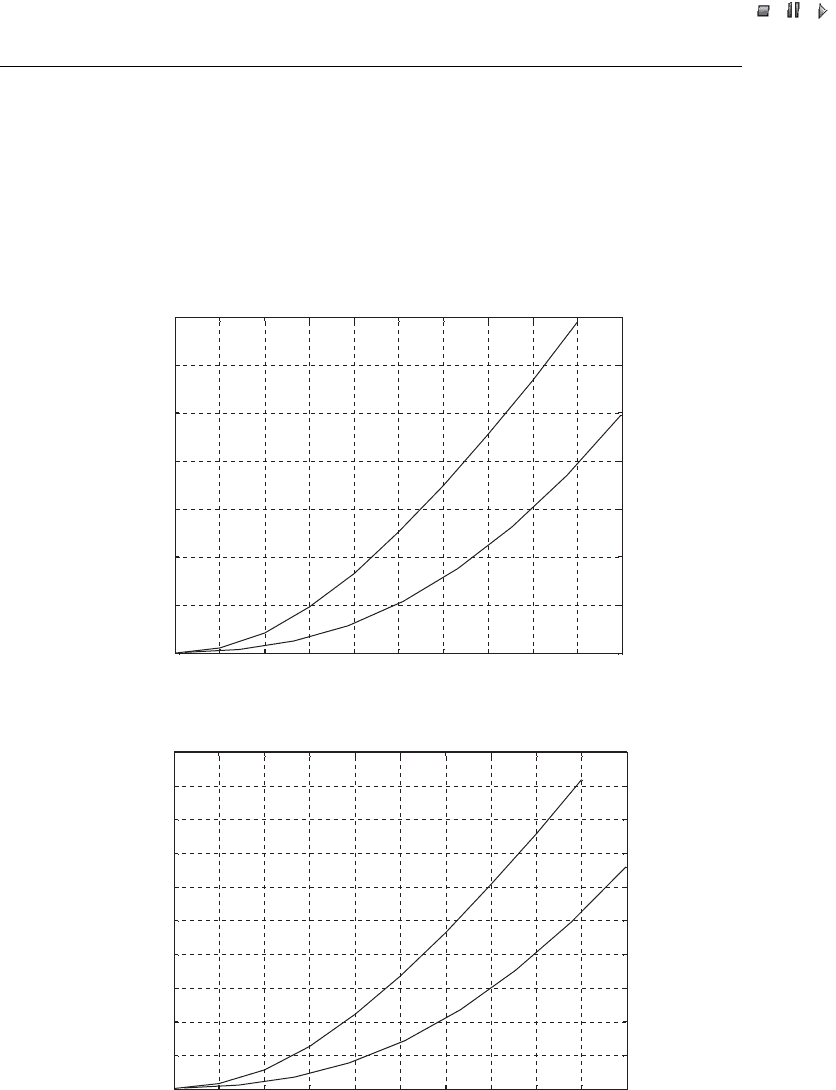AckermannTh. (ed) Wind Power in Power Systems
Подождите немного. Документ загружается.


//INTEGRAS/KCG/P AGIN ATION/ WILEY /WPS /FINALS_1 4-12- 04/0470855088_ 21_CHA20 .3D – 451 – [433–460/28]
17.12.2004 10:43PM
The distribution function of the discrete variable Z is
F
Z
ðzÞ¼
X
i: z
i
Z
f
Z
ðz
i
Þ: ð20:7Þ
It is more convenient to use a duration curve instead of a distribution function as it
shows the probability of exceeding a certain level (e.g. 1 F
Z
(z) ¼ P(Z z)). Figure 20.9
illustrates the results of the discrete probabilistic estimation for the same case as before.
In this figure, the value 1 F
Z
(z ¼ TL) corresponds to the probability of exceeding the
transmission limit. If the transmission limit is equal to 7000 MW, the probability that the
transmission limit is exceeded is 0.05.
Continuous probabilistic method
The discrete probabilistic method can be generalised for applications where long-term
measurements are not available. Variables X , Y and Z are then assumed to be continu-
ous with a known distribution law. For variable X , we assume the Gaussian function
with a known mean value m
G
and a standard deviation :
f
X
ðxÞ¼
1
ð2Þ
1=2
exp
ðx m
G
Þ
2
2
2
"#
: ð20:8Þ
The corresponding distribution function is
F
X
ðxÞ¼
Z
x
0
f
X
ðuÞdu ¼
1
ð2Þ
1=2
Z
x
1
exp
ðu m
G
Þ
2
2
2
"#
du; ð20:9Þ
where u is the integration variable.
0 1000 2000 3000 4000 5000 6000 7000 8000 9000
0
0.1
0.2
0.3
0.4
0.5
0.6
0.7
0.8
0.9
1
Power (MW)
Probability
1–F(y)
1
– F(z)
1–F(x)
Figure 20.9 Wind power production, actual transmission and desired transmission duration
curves – 1 F
X
(x), 1 F
Y
(y) and 1 F
Z
(z) respectively – obtained from a discrete probabilistic
estimation (transmission limit ¼ 7000 MW)
Wind Power in Power Systems 451

//INTEGRAS/KCG/P AGIN ATION/ WILEY /WPS /FINALS_1 4-12- 04/0470855088_ 21_CHA20 .3D – 452 – [433–460/28]
17.12.2004 10:43PM
For wind power applications, the Reighly or, more generally, the Weibull func-
tions are representative (Burton et al., 2001). In this case, we will use the Weibull
function. For this function, the shape parameter k can be adjusted to fit better the
discrete data:
f
V
ðvÞ¼
k
g
v
g
k1
exp
v
g
k
"#
; ð20:10 Þ
F
V
ðvÞ¼
k
g
k
Z
v
0
u
k1
exp
u
g
k
"#
du; ð20:11Þ
where v is the wind speed in m/s; and k and g are, respectively, the shape and scale
parameters of the Weibull distribution.
Now it is necessary to arrive from wind speed v at power output y in megawatts. If a
power curve,
y ¼
1
2
c
p
A
R
V
3
10
6
;
of a pitch-regulated wind turbine is approximated by a smooth, increasing function, it
can be inverted according to the following equation:
vðyÞ¼
2y 10
6
A
R
c
p
ðyÞN
WT
1=3
; ð20:12Þ
where A
R
is the swept area in m
2
, c
p
(y) is the performance coefficient of the turbine, is
the air density in kg/m
3
, and N
WT
is the number of wind turbines (WTs).
Substituting Equation (20.12) in Equation (20.10), we obtain the probability density
and distribution functions of the wind power production:
f
Y
ðyÞ¼
k
g
k
2y 10
6
A
R
c
p
ðyÞN
WT
ðk1Þ=3
exp
2y 10
6
A
R
c
p
ðyÞN
WT
g
3
k=3
; ð20:13Þ
F
Y
ðyÞ¼
Z
y
0
f
Y
ðuÞdu ¼
k
g
k
Z
y
0
vðuÞ
k1
exp
vðuÞ
g
k
"#
dvðuÞð20:14Þ
where v is expressed according to Equation (20.12).
The probability density function for the desired transmission f
Z
(z) is obtained from
the convolution expression (Grimmett and Strizaker, 1992):
f
Z
ðzÞ¼
Z
y
max
o
f
X
ðz yÞf
Y
ðyÞdy: ð20:15Þ
452 Areas with Limited Transmission Capacity

//INTEGRAS/KCG/P AGIN ATION/ WILEY /WPS /FINALS_1 4-12- 04/0470855088_ 21_CHA20 .3D – 453 – [433–460/28]
17.12.2004 10:43PM
Finally, the distribution function of the continuous variable Z is calculated:
F
Z
ðzÞ¼
Z
z
1
f
Z
ðuÞdu: ð20:16Þ
The quantity 1 F
Z
(z ¼ TL) corresponds to the probability of exceeding the transmission
limit. The integral of 1 F
Z
(TL z < 1) is equal to the wind energy that has to be
spilled. The details of this method are given in Sveca and So
¨
der (2003).
As was mentioned above, the simplified method will give a rough estimation, but it
will represent the worst case that can occur in the area with bottleneck problems. This
method is also easily applied and does not require major computational resources.
If detailed data about transmission and wind speeds are available, simplified and
discrete probabilistic estimations may be used. The continuous method should be
applied if only the mean value and deviation are available. However, the continuous
method has one limitation. We have assumed that all turbines are of the same type,
although in reality this is not always true. This complication can be dealt with easily in
the simplified or discrete probabilistic method, but for the continuous method the
solution will be rather complex.
20.6.2.3 Application to the Swedish transmission system
In order to present a possible application of the suggested methods, we use them to
study the large-scale integration of wind power in northern Sweden and to weigh the
cost of the spilled wind energy against the cost of grid reinforcement. Some of the results
have already been presented in the preceding sections to illustrate the suggested methods.
In the following, we will provide some facts regarding the Swedish power system.
Swedish power system
The Swedish transmission system was built to utilise hydro power as efficiently as
possible, to match the increased electricity consumption. The total installed capacity of
the generating units is about 32 000 MW, of which 51.2 % is hydro power, 29.8 % is
nuclear power and 18.1 % thermal power. Installed wind power capacity corresponds
to about 1.1 % of total installed capacity. The largest hydropower plants are situated in
the north, and eight long 400 kV transmission lines co nnect the northern part of the
transmission system with the central and southern parts, where the main load is
concentrated. During cold days, when power consumption is high, or during the spring
flood, when power production is high, a lot of power is transferred from the north, and
the power transmission capacity almost reaches its limits. There are also other trans-
mission limits inside the Swedish power system and towards neighbouring countries
(Nordel, 2000).
The development of wind power in Sweden is much slower compared with Denmark,
Germany and Spain, for instance. The installed capacity of wind power amounts to
426 MW (Sept. 2004) divided among 706 wind turbines. The wind farms and wind
turbines are mostly spread along the southern coast, onshore and near the shore of
the islands of Gotland and O
¨
land.
Wind Power in Power Systems 453

//INTEGRAS/KCG/P AGIN ATION/ WILEY /WPS /FINALS_1 4-12- 04/0470855088_ 21_CHA20 .3D – 454 – [433–460/28]
17.12.2004 10:43PM
The Swedish Government proposed a bill (Governmental Bill 2001/02: 143) on
planning objectives for wind power. According to this bill, the objective of 10 TWh of
wind power production per year has to be achieved up to 2015. The bill was passed in
2002 and since then several studies have been conducted in order to draw up prerequis-
ites for the integration of wind power in Sweden.
Energimyndigheten, the country’s energy authority, has prepared a report pointing
out areas that have suitable conditions for the integration of wind power . One alter-
native that was suggested was to develop large-scale wind power in the mountainous
area in the north of the country. Favourable wind conditions and better economic
conditions than for offshore wind farms make the area attractive for this purpose, even
though the transmission capacity is limited.
In 2002, the Swedish government commissioned TSO Svenska Kraftna
¨
t to define
general prerequisites for an integration of large-scale wind power (10 TWh) in the
mountain area and offshore. The resulting report considers a case with 4000 MW of
installed capacity with a utilisation time of 2500 h in northern Sweden (Arnborg, 2002).
According to the report, five new 400 kV transmission lines at a total cost of SEK20
billion would be required to guarantee electricity transmission available for 100 % of the
year (for the exchange rate, see Footnote 1, page 444).
Assumptions and results
The following assumptions are made:
.
Data from 2001 were used to arrive at the probability distributions.
.
Only the inner transmission limit is considered. It is assumed that exports to neigh-
bouring countries are not affected.
.
The transmission limit is assumed to be constant.
.
Power generated in northern Sweden can be consumed in the central and southern
parts of the country.
.
Only active power flows are considered, assuming that reactive power compensation
can be controlled in hydro power plants.
.
Variations of active power output at wind farms are not compensated by regulation at
hydro power plants.
In addition, wind speed measurements available from the existing wind turbines in
Sourva (northern Sweden) were used. The expected power output is obtained from a
typical power curve for a pitch-regulated wind turbine. The calculated power output was
then scaled up to represent different levels of installed capacity.
Figure 20.10 illustrates the percentage of wind energy that has to be spilled at various
wind power penetration levels. The results were obtained by usind the probabilistic and
the sim plified method. For a comparison, the calculation is also perfomed to obtain
hourly values in 2001. Here, wind power production is modell ed using hourly wind
speed measurements from Sourva and scaling up the power output in order to represent
different levels of installed capacity. Actual hourly power transmission from 2001 is
included in the analysis. The expected power transmission with wind power is calculated
by summing these two variables for each hour. The resulting power transmission is
compared with the transmission limit of 7000 MW and the annual energy spillage is
454 Areas with Limited Transmission Capacity

//INTEGRAS/KCG/P AGIN ATION/ WILEY /WPS /FINALS_1 4-12- 04/0470855088_ 21_CHA20 .3D – 455 – [433–460/28]
17.12.2004 10:43PM
calculated for each wind power penetration level. During 2001 the correlation between
the wind speed measured in Sourva and the power transmission was 0:06. That means
that during 2001, the highest wind speeds in northern Sweden were reached during
periods when the transmission was slightly lower than the maximum. This result is
closer to the probabilistic estimation methods, where transmission and wind power
generation are considered to be independent variables. Therefore, we will mainly use
the results of the discrete probabilistic method in the followi ng analysis.
Economic evaluation
According to (Arnborg 2002), 4000 MW of additional transmission capacity will cost
SEK20 billion, which for a 10 % interest rate and 40-year lifetime will amount to
SEK2 billion per year. This is the cost of five new 400 kV transmission lines with a
transmission cap acity of approximately 800 MW per line. Therefore, if a new line is
built, it will have to reduce wind energy spillage by at least SEK400 million per year in
order to be economically feasible.
In Figure 20.11(a) the spillage of wind energy illustrated in Figure 20.10 is expressed
in millions of SEK per year assuming spillage costs of SEK0.3 per kilowatt-hour. Using
the discrete probabilistic method, the wind energy spillage at a penetration level of
4000 MW of wind power will cost approximately SEK455 million per year. If a new
transmission line is built, 800 MW of wind power can be transmitted without spillage
and the residual 3200 MW will be subject to a spillage of 11.6 % of the annual wind
energy output. The cost of the spillage is then SEK260 milli on per year. This means that
500 1000 1500 2000 2500 3000 3500 4000 4500 5000 5500
0
5
10
15
20
25
30
35
Installed wind power (MW)
Calculation
with data from
2001
Spill (%)
Simplified
method
Probabilistic method
Figure 20.10 The percentage of wind energy that has to be spilled at various wind power
penetration levels, estimated by the simplified method, the discrete probabilistic method and
calculated with the actual correlation coefficient for the year 2001 (regulation with hydro power
is not included)
Wind Power in Power Systems 455

//INTEGRAS/KCG/P AGIN ATION/ WILEY /WPS /FINALS_1 4-12- 04/0470855088_ 21_CHA20 .3D – 456 – [433–460/28]
17.12.2004 10:43PM
the new transmission line will decrease costs for spillage to SEK195 million per year
(i.e. SEK(455 260) million per year). The cost of a line is SEK400 million per year.
Therefore, there is no economic incentive to build a new line, given the assumptions
made above.
If we assume that wind energy spillage costs SEK0.4 per kilowatt-hour and analyse
total costs for spillage versus grid reinforcement costs in the same way as above
(Figure 20.11(b)), the costs for spilled energy at 4000 MW wind power penetration are
500 1000 1500 2000 2500 3000 3500 4000 4500 5000 5500
0
200
400
600
800
1000
1200
1400
Installed wind power (MW)
Installed wind power (MW)
500 1000 1500 2000 2500 3000 3500 4000 4500 5000 5500
0
200
400
600
800
1000
1200
1400
1600
1800
2000
Simplified
method
Probabilistic
method
Probabilistic
method
Simplified
method
Cost per year (SEK millions)
Cost per year (SEK millions)
(a)
(b)
Figure 20.11 Total cost of spilled wind energy at (a) SEK0.3 per kWh and (b) SEK0.4 per kWh,
calculated by the simplified method and the discrete probabilistic method
456 Areas with Limited Transmission Capacity

//INTEGRAS/KCG/P AGIN ATION/ WILEY /WPS /FINALS_1 4-12- 04/0470855088_ 21_CHA20 .3D – 457 – [433–460/28]
17.12.2004 10:43PM
SEK600 million per year. For 3200 MW (i.e. 4000 MW 800 MW), these costs are
SEK346 million per year. Consequently, a new transmission line decreases the cost of
wind energy spillage to SEK254 million per year (i.e. SEK(600 346) million per year).
The conclusion is that even in this case there is no economic incentive to build a new
transmission line at 4000 MW of wind power penetration in northern Sweden.
Discussion of assump tions
In this subsection, the impact of different assumptions on the results of the estimation is
summarised:
.
In the analysis, wind data from only one site and the power curve of only one turbine
were used and scaled up to represent various wind power penetration levels. In reality,
however, the wind turbines will be of various types and spread over a wide area. This
would lead to a decrease in spilled energy because spillage becomes necessary at high
wind speeds, which are not likely to occur simultaneously over a large area.
.
It was assumed that there is no regulation in hydro power plants during wind power
production peaks. In reality, such regulation could be profitable both for hydro power
plants and for wind farm owners if an arrangement can be reached such as one where
the water can be stored in reservoirs and a certain revenue received later (see also
Section 20.6.1), as wind power cannot be stored (for large-scale wind farms, battery
storage is an expensive option). If such an approach is used, wind energy spillage can
be substantially reduced.
.
If wind energy spillage is lower than determined in the analysis above, the grid
reinforcement will appear even less economically attractive. However, grid reinforce-
ment may be seen as attractive if a lower interest rate is used in the calculation.
Another consideration may be that the grid reinforcement will enhance competition
and increase transmission capacity, which reduces the risk of a cap acity deficit.
.
It was assumed in the analysis that all wind turbines are of the same type and that
reactive power compensation is provided by hydro power plants. However, when it
comes to large-scale wind power, the wind turbi ne type is very important in terms of
reactive power regulation capab ilities and possible impact on transmission limits.
.
Transmission limits are defined by the TSO, based on n 1 criteria and are not subject
to substantial variation. However, it is possible to define the transmission limits as a
function of weather conditions, power prices and other factors affecting the grid
operating costs, for instance (Uhlen et al., 2000). In this case, the transmission limit
would become variable, and that could have an impact on the spillage of wind energy.
The analysis above shows that the spilling of wind energy during periods of high hydro
power production and full water reservoirs (e.g. during the spring flood) is a natural
consequence because expansion of transmission capacity is a more expensive option.
20.6.3 Summary
In this section we have introduced alternative methods for the large-scale integration of
wind power into areas with limited transmission capacity. There are two general
methods: storage of excess wind power, or spillage. Even though spillage of energy
Wind Power in Power Systems 457

//INTEGRAS/KCG/P AGIN ATION/ WILEY /WPS /FINALS_1 4-12- 04/0470855088_ 21_CHA20 .3D – 458 – [433–460/28]
17.12.2004 10:43PM
may seem irrational it has been shown that in some cases it could be a more economic
option than the construction of new transmission lines. The results of such an analysis,
however, are highly dependent on input data and assumptions. Therefore, the estima-
tion of wind energy spillage should be carefully considered for each individual project.
The possibilities of energy storage, measures for grid reinforcem ent and even ‘soft’
measures to increase transmission capacity should be weighed against the estimated
wind energy spil lage.
20.7 Conclusions
The available transmission capacity is not a fixed value determined only by the technical
properties of the system. It also reflects the policies and assumptions of the respective
TSOs. Therefore, ‘soft’ measures to increase transmission capacity that concern
methods of capacity determination and ‘hard’ measures that concern the installation
of new equipment and the building of new transmission lines can be applied.
Such measures are relevant for any type of new generation. The integration of wind
power may, however, put additional constraints on the determination of transmission
capacity. However, because of its low utilisation time, there are alternative ways to
increase the penetration of wind power in congested areas. For each particular project,
there is an optimal combination of measures.
References
[1] Arnborg, S. (2002) Overall Prerequisites for Expansion of Large-scale Wind Power Offshore and in
Mountainous Areas, Svenska Kraftna
¨
t, Stockholm.
[2] Bergstro
¨
m, H., Ka
¨
llstrand, B. (2000) ‘Measuring and Modelling the Wind Climate in Mountain Valley in
Northern Sweden’, in Proceedings of Wind Power Production in Cold Climate Conference, BOREAS V,
Finland.
[3] Booth, R. R. (1972) ‘Power System Simulation Model Based on Probability Analysis’, IEEE Transactions
on PAS, 91, 62–69.
[4] Breidablik, Ø., Giæver, F., Glende, I. (2003) Innovative measures to increase the utilization of Norwegian
transmission, in Proceedings of IEEE Power Tech Conference, Bologna, edited and published by Faculty
of Engineering, University of Bologna, Bologna.
[5] Burton, T., Sharpe, D., Jenkins, N., Bossanyi, E. (2001) Wind Energy Handbook, John Wiley & Sons Ltd,
Chichester, UK.
[6] Douglas, D. (2003) ‘Can Utilities Squeeze more Capacity out of the Grid?’ Transmission and Distribution
World (November) 38–43; available at www.tdworld.com.
[7] Gardner, P. Snodin, H., Higgins, A., McGoldrick, S. (2003) The Impacts of Increased Levels of Wind
Penetration on the Electricity Systems of the Republic of Ireland and Northern Ireland: Final Report,
Garrad Hassan and Partners Ltd.; available from www.cer.ie/cerdocs/cer03024.pdf.
[8] Grimmett, G. R., Strizaker, D.R. (1992) Probability and Random Processes, Clarendon Press, Oxford,
pp. 33–114.
[9] Haubrich, H.-J., Zimmer, C., von Sengbusch, K., Fritz, W., Kopp, S. (2001) ‘Analysis of Electricity
Network Capacities and Identification of Congestion’, report commissioned by the European Commis-
sion Directorate-General Energy and Transport; available from www.iaew.rwth-aachen.de/publikatio-
nen/EC_congestion_final_report_main_pact.pdf.
[10] Ha
¨
usler, M., Schlayer, G., Fitterer, G. (1997) ‘Converting AC Power Lines to DC for Higher Transmis-
sion Ratings’, ABB Review 3, 4–11.
[11] Heier, S. (1998) Wind Energy Conversion Systems, John Wiley & Sons Ltd, Chichester, UK.
458 Areas with Limited Transmission Capacity

//INTEGRAS/KCG/P AGIN ATION/ WILEY /WPS /FINALS_1 4-12- 04/0470855088_ 21_CHA20 .3D – 459 – [433–460/28]
17.12.2004 10:43PM
[12] House, H. E., Tuttle, P. D. (1958) ‘Current-carrying Capacity of ACSR’, presented at the AIEE Winter
General Meeting, New York.
[13] Kundur, P. (1993) EPRI Power System Engineering Series: Power System Stability and Control,
McGraw-Hill, New York.
[14] Matevosyan, J., So
¨
der, L (2003) ‘Evaluation of Wind Energy Storage in Hydro Reservoirs in Areas with
Limited Transmission Capacity’, in Proceedings of the Fourth International Workshop on Large-scale
Integration of Wind Power and Transmission Networks for Offshore Wind Farms, October 2003, Billund,
Denmark, edited and published by the Department of Electrical Engineering, Royal Insitute of Technolgy,
Stockholm, Sweden.
[15] Nordel (2000) ‘Nordel Annual Report’, http://www.nordel.org.
[16] Sveca, J., So
¨
der, L. (2003) ‘Wind Power in Power Systems with Bottleneck Problems’, in Proceedings of
IEEE Power Tech Conference, Bologna, edited and published by the Faculty of Engineering, University of
Bologna, Bologna.
[17] Swedish Government (2001) ‘Collaboration for Secure, Efficient and Environmentally Friendly Energy
Supply’, Government Bill 2001/02: 143, Swedish Government, Stockholm [in Swedish].
[18] Uhlen, K., Kjølle, G. H., Løva
˚
s G. G., Breidablik, Ø. (2000) ‘A Probabilistic Security Criterion for
Determination of Power Transfer Limits in a Deregulated Environment’, presented at Cigre Session,
Paris.
[19] Van Cutsem, T., Vournas, C. (1998) Voltage Stability of Electric Power Systems, Kluwer Academic,
Dordrecht.
[20] Vogstad, K.-O. (2000) ‘Utilising the Complementary Characteristics of Wind Power and Hydropower
through Coordinated Hydro Production Scheduling using the EMPS Model’, in Proceedings from Nordic
Wind Energy Conference, NWPC’ 2000, Trondheim, Norway, 13–14 March 2000, edited and published by
the Norwegian Institute of Technology, Norway, pp. 107–111.
[21] Wiik, J., Gustafsson, M., Gjengedal, T., Gjerde, J. O. (2000) ‘Capacity Limitations on Wind Farms in
Weak Grids’, in Proceedings of the International Conference: Wind power for the 21st century, Kassel,
edited and published by WIP-Renewable Energies, Germany, www.wip-munich.de.
Wind Power in Power Systems 459

//INTEGRAS/KCG/P AGIN ATION/ WILEY /WPS /FINALS_1 4-12- 04/0470855088_ 21_CHA20 .3D – 460 – [433–460/28]
17.12.2004 10:43PM
